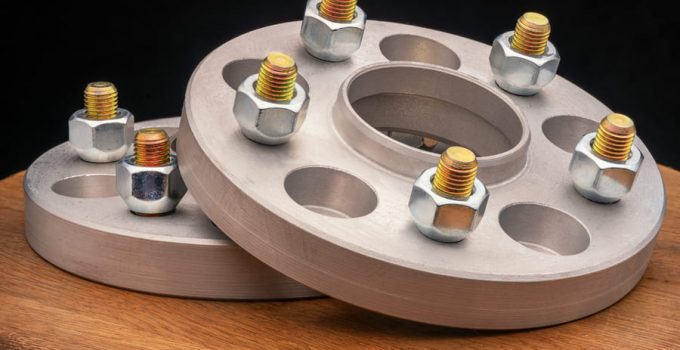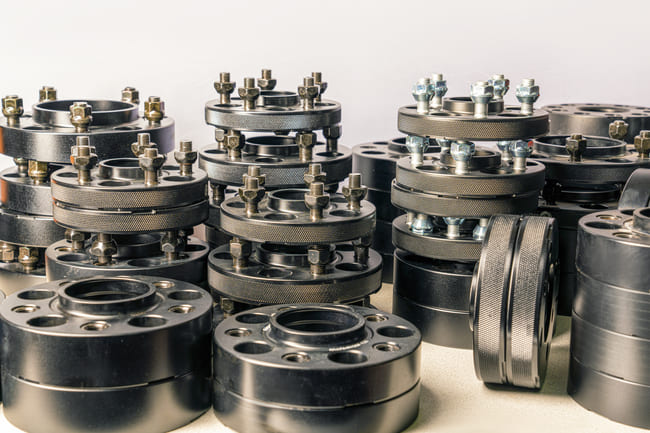
To understand wheel spacers, you first need to know what they are all about. In principle, such changes are used as part of vehicle tuning. The aim here is to increase the track width or, colloquially, to increase the wheelbase. The main goal is to make the vehicle look beefier and sportier overall. A wheel spacer is almost always combined with lowering the vehicle. Due to the fact that the wheels move out to the side and the wheels are lower in the wheel arch, both result in the mounted wheels filling out the wheel arch better. With regard to driving dynamics and driving safety, such a measure can have both positive and negative effects. What predominates depends above all on the specific driving situation – but more on that later. First, we want to deal with how a widening of the track is possible and what is meant by spacers and track plates.
Contents
What are the possibilities of widening the track?

The most common way to increase the track width is to simply mount a so-called spacer between the wheel hub and the rim. The basic principle of widening the track with the help of a spacer is easy to explain: With these additional components, the wheels no longer sit directly on the wheel hub, which means they move further outwards. Two identical track plates are always required per axle, so that the total track width is always twice as high as the thickness of one of the spacers. Another alternative way to increase the track width is to fit wheels that have a negative offset. In many cases, tuners use both variants in combination. However, you should always bear in mind that the vehicle operating permit can expire if you mount wheels with an offset that is far too negative. Incidentally, the same applies to wheel spacers in general. You should therefore absolutely refrain from manufacturing this type of component yourself or having it manufactured. In principle, it may also be necessary for you to have the wheel spacers entered in your vehicle documents.
What needs to be considered with spacers?

If you want to mount track plates on your vehicle, you should first decide whether this should be done on one or both axles. The installation on an axle is usually an absolute exception. First of all, you should then inquire about how much wheel spacers make sense. Of course, it is also about what is permitted at all. The amount of wheel space that is generally permitted depends in particular on the so-called ET limit, which the appraiser also consults when accepting your vehicle. The selected wheel-track plate combination must not fall below this value. In addition, you must ensure that your wheel does not protrude from the fender at the end. To get more detailed information, it may be worth speaking to an expert in advance or using a suitable rim calculator. So you know exactly how much wheel spacers are allowed.
If the track width is only slightly increased, track plates without a collar are usually sufficient, because the wheel hub then protrudes far enough that your wheel can still be attached centrally via the centering hole. If you want to push the limits of what is technically possible, such components are also available with a collar. The collar is used as the outer centering, which means that you also need rims with a larger center hole.
With regard to the wheel bolts, you should make sure that you need new, longer bolts. This is because the original screws could no longer be screwed in far enough, since the distance has increased. For this reason you inevitably need wheel bolts that are just as much longer as your spacer plate is thick.
What are the advantages and disadvantages of wheel spacers?
We have already described how the appearance of your car differs before and after wheel spacers. But this section is about what the differences are between before and after when installing the spacers. Basically, you will notice greater stability, especially tracking, when driving. This is especially true when cornering. This is due to an increase in the distances between the ground contact surfaces – even a few millimeters can be noticeable here. The improved look of the vehicle is particularly effective if you combine this tuning measure with the installation of large rims and/or wide tires.
But of course there are also disadvantages of a widened track. This includes, for example, the increase or unfavorable shifting of the unsprung mass. In addition, your entire vehicle steering mechanism must endure greater leverage. As a result, the service life of some particularly stressed components is significantly reduced. These include, for example, the wheel bearings, the stabilizers, the tie rods and the corresponding ball joints. All in all, with this improvement in vehicle optics, you risk premature wear and tear on certain vehicle parts.
How does a wheelspace width work?

In principle, the assembly of the corresponding components is not particularly complex. If you can change a wheel yourself, have the right tool at hand and bought the right wheel spacers and wheel bolts, you can do the installation yourself. In any case, a wheel cross or a corresponding socket wrench, a torque wrench, a lifting platform or a jack with parking blocks and wheel chocks are required.
In the first step, loosen the wheel bolts after you have parked your car safely, switched off the engine and tightened the handbrake. You should secure it with wheel chocks to prevent it from rolling away. Then jack up the car with the jack or the lifting platform. When using a jack, you should also secure your raised vehicle with jackstands. Now unscrew the wheel bolts completely and remove the wheel. Then the track plate is mounted according to the manufacturer's specifications before the wheel is properly fastened again. To do this, tighten the new wheel bolts one after the other, always switching to the opposite bolt. After the vehicle has been lowered, the wheel bolts are tightened to the specified torque using the torque wrench.
Conclusion
Spacers have been enjoying increasing popularity for years. This is due, among other things, to the positive influence on the external appearance of the vehicle. From the point of view of driving safety and driving dynamics, there are clear limits to how much manipulation makes sense. All in all, it is a very easy to implement and inexpensive way to make your own vehicle look sportier and beefier.
A tip from CarTipsandmore: Do not use spacers you have made yourself, because this is illegal and can also be dangerous. This is partly due to a lack of balancing and a safety check that was not carried out. Only use registrable and tested wheel spacer sets to be on the safe side. If there is a so-called general operating permit (ABE), it must always be carried in the vehicle.
